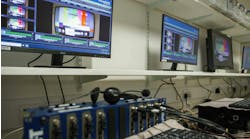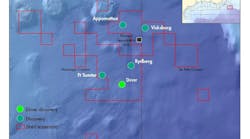John Mulholland
Daniel McStay
FMC Technologies Ltd.
Wireless technology is established as a powerful communication and network tool in many surface applications. The adoption of a wireless approach to producing highly instrumented subsea equipment removes the physical cabling requirement; and this, when combined with the associated reduction in cost, makes it far more practical and cost-effective to deploy and maintain a far greater number of sensors. The technology may also offer benefits for temporary setups, during system installation; and in workover operations.
In developing a wireless network approach for enhanced subsea production monitoring systems, it is important to ensure that the approach supports the instrumentation required. Such instrumentation may include a range of devices with differing control and output data requirements. This may range from low data rate temperature sensors to high data rate video systems. For this reason it is necessary to include a wide communication capability. In addition to the device data requirements, there will be a requirement for short-range wireless communications for on-system applications, such as the subsea tree, and longer range communications for pan-field applications like monitoring along risers.
The complexity of the metal structures of subsea wellheads and trees, along with the associated flow lines, pumps, and valves, poses a challenge for wireless systems. In developing the wireless network for subsea production systems, it is important to account for the complexity of the metal structures and to ensure that the wireless technology used and network design minimize potential problems of interference reflection, background noise, etc. Due consideration also should go to data rate requirements for each instrument, in order to minimize the power consumption of the wireless sensor.
Wireless technology
Surface wireless systems commonly use radio frequency transmissions, although optical systems are used often for high data rate point-to-point communications. In contrast, historically the principal wireless communications technique underwater is acoustics. Its capabilities, practicalities, and limitations are well known. Acoustic communications have low to medium data rates and are limited by background noise as well as noise from subsea equipment such as pumps. Data rates for acoustic communications are limited to around tens of thousands of bits per second (bit/s) for ranges of a kilometer and less than a thousand bit/s for ranges up to 100 km (62 mi). Subsea acoustic communications are also affected by temperature gradients and air bubbles in the water. Still, subsea acoustics are efficient at long-range subsea communications and have relatively low power consumption for their range. The ability to communicate over long distances subsea is perhaps acoustic technologies’ greatest advantage. However, the speed of acoustic waves in sea water is approximately 1,500 m/s. This means that for long-range communication there is high latency. Latency constitutes problems for applications requiring real-time response, synchronization, and multiple-access protocols.
Considerable effort has been directed to develop underwater wireless acoustic networks. However, the most common commercial acoustic modems are designed primarily for point-to-point communication rather than for network operations. There are challenges to be addressed to produce practical, low cost ad hoc network systems. These include high bit error rates due to multi-paths scenarios, complex architecture, path redundancy, and increased network functionality. With a large number of sensors, the limited bandwidth may be critical. Advanced processing and system designs are being developed to enable higher data rates, more robust links, and to address latency, reflections, and ray divergence.
Therefore, it is not surprising that alternative subsea wireless technologies have been attracting interest for subsea sensor networks and particularly for highly instrumented subsea production equipment.
Optical wireless
Optical wireless or free space optical (FSO) communications have been used in surface applications for decades. In particular they have found favor in point-to-point secure high bandwidth (Gbit/s) links over ranges of up to a few kilometers. These capabilities make FSO potentially useful for subsea wireless network applications. For subsea applications, the technology essentially is the same as for surface systems, but the operating wavelengths and ranges are restricted. These are determined by the optical properties of the sea water at the location. In addition to water, which absorbs strongly towards the red and infra-red, there are a number of variables that impact the optical properties of sea water. These include dissolved salts such as NaCl, Na2SO4, and KCl typically found in sea water, that absorb light at specific wavelengths. The relative abundance of chlorophyll and plankton also impacts the overall absorption properties of the seawater, as will turbulence and disturbed sediments. The lowest absorption for typical seawater occurs in the 400–500 nm wavelength region, which is the blue-green region of the visible light spectrum. As well as absorption, light propagating through seawater is subject to Rayleigh scattering. Scattering not only contributes to the overall attenuation of the light propagating in the sea water, but multi-scattering also causes optical pulses to widen in the spatial, angular, temporal, and polarization domains.
Schematic of an integrated subsea wireless system comprising acoustic, optical, and magnetic induction systems.
To be effective subsea FSO systems need to operate in the blue-green spectral region. Recent advances in light emitting diode (LED) and laser diode technology have produced efficient, compact, long life time optical sources emitting in this range. Similarly, there are a number of efficient optical detectors for these operating wavelengths. In addition to the band widths achievable from LED or laser diode sources, the choice of optical source for a particular application depends on the angular spread, or beam divergence. For high bandwidth point-to-point communications, laser diodes generally are preferable. For lower bandwidth applications involving multiple nodes, the greater angular spread of LEDs may make them preferable.
Radio frequency wireless
Radio frequency (RF) wireless networks are used extensively for surface through air applications. The transmission of RF electromagnetic waves through sea water is, very different from that through air due to the high permittivity and electrical conductivity of sea water. These properties mean RF signals are strongly absorbed in sea water. However, the transmission properties of water depend upon the frequency of the RF signals.
Newer subsea RF communications systems that use digital technology and signal compression are capable of data rates of 100 bits/s up to 100 m and up to 100 kbit/s over 10 m. These data rates potentially make the technology useful for subsea wireless sensor networks for production monitoring applications. However, these systems have high power requirements on both transmit and receive sides, making them less practical in a deployable wireless solution.
Recently preliminary reports have surfaced about higher-frequency subsea RF systems that use a less well-known feature of through-water transmission (Debye relaxation). Although the near-field energy of such a system is absorbed rapidly by the water, a weaker far-field component with, for example a 5 MHz signal, may be detected over tens, and potentially hundreds of meters.
Subsea RF communications are immune to acoustic noise but can be impacted by salinity variations in the sea water and by subsea RF interference from electrical equipment. In developing an RF wireless network for hydrocarbon production systems, it is important to account for complex metal structures and to ensure that the wireless network design minimizes potential problems associated with interference and reflection.
Magnetic induction wireless
Magnetic induction (MI) based wireless communications systems are capable of working in a range of environments. MI works by generating, modulating, and detecting magnetic fields. MI transmitters generate a highly localized dipole field with no far field (RF) emissions. This eliminates possible detection outside of the operating area. However, existing MI communications systems suffer from high power consumption and limited data rates, with typical performance being 100s of kbit/s over a few meters and 2 kbit/s at 100 m.
MI is immune to scattering and reflection, and can penetrate water, ice, earth, and rock. These features mean MI can provide wireless communications where traditional wireless systems cannot.
Power supply
One key challenge to subsea wireless systems for enhanced production monitoring is the powering of both the sensors and wireless communications. The obvious option is an energy storage device, battery, or power storage capacitor for each wireless sensor node. The limited storage capacity of such devices may not be appropriate for long-term subsea deployment, which could reach 25 years. Incorporating subsea energy scavenging or generation into each wireless sensor or node may be a reliable option. Energy scavenging may be augmented by energy storage within the sensor or node. Although still at a relatively early stage of development, there are energy scavenging or generating techniques that might be suitable for subsea wireless systems.
Integrated systems
From this discussion, it can be seen that all the wireless technologies have advantages and disadvantages for subsea application, but that none is capable of satisfying all the requirements listed. In practice, it is necessary to adopt an integrated approach using several wireless technologies. The exact composition of a given network depends on the local conditions (application geometry, turbidity, background noise levels, network structures required, available power, etc.) and data requirements. For example, a FSO network may provide short-range, on-system high bandwidth communication networks and acoustics to communicate with remotely located devices. It should be possible to create effective wireless sensing networks to support enhanced production monitoring. In operation, the wireless network will meet with a wired communications and control backbone that may be fiber optic or copper based that can transmit the data to shore.
An integrated subsea wireless sensing network will have wide scale applicability in areas such as:
- Asset integrity and flow assurance monitoring
- Communication to intervention systems
- Back up communication channels
- Retrofit and repair solutions for sensors/jumpers
- Remote/temporary abandoned structures
- Environmental monitoring systems.
Offshore Articles Archives
View Oil and Gas Articles on PennEnergy.com





